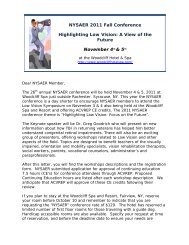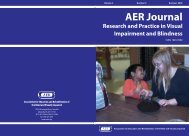Association for Education and Rehabilitation of the Blind - AER Online
Association for Education and Rehabilitation of the Blind - AER Online
Association for Education and Rehabilitation of the Blind - AER Online
Create successful ePaper yourself
Turn your PDF publications into a flip-book with our unique Google optimized e-Paper software.
Integrated <strong>Education</strong>al Facilities in Nepal<br />
asked if teachers would be willing to participate in an<br />
interview. There<strong>for</strong>e, in<strong>for</strong>mation ga<strong>the</strong>red in <strong>the</strong><br />
interviews was in no way connected to questionnaire<br />
responses. In addition to <strong>the</strong> subjects mentioned<br />
previously, questions about TVIs’ suggestions <strong>for</strong><br />
improving <strong>the</strong> quality <strong>of</strong> education <strong>for</strong> students with<br />
visual impairments were also included.<br />
Data Analysis<br />
The data were analyzed by calculating frequencies<br />
<strong>and</strong> percentages. Mean comparison tests were<br />
per<strong>for</strong>med to compare facilities <strong>and</strong> services <strong>for</strong><br />
students with visual impairments. Data from TVIs in<br />
rural <strong>and</strong> urban schools were compared in light <strong>of</strong> <strong>the</strong><br />
generally held view that urban schools are equipped<br />
with better facilities <strong>for</strong> students with visual impairments<br />
than <strong>the</strong>ir rural counterparts. A mean comparison<br />
test was per<strong>for</strong>med to analyze <strong>the</strong> quantitative<br />
data, <strong>and</strong> <strong>the</strong> t test was used to examine <strong>the</strong> statistical<br />
significance <strong>of</strong> <strong>the</strong> parameters <strong>of</strong> <strong>the</strong> mean comparison<br />
test at <strong>the</strong> given level <strong>of</strong> significance. The following<br />
hypo<strong>the</strong>ses were used to compute <strong>the</strong> t test statistics:<br />
N Null hypo<strong>the</strong>sis: There is no significant<br />
difference between <strong>the</strong> mean value <strong>of</strong> rural<br />
<strong>and</strong> urban schools.<br />
N Alternative hypo<strong>the</strong>ses: The mean value in<br />
rural areas is lower than that <strong>of</strong> urban areas,<br />
or, conversely, <strong>the</strong> mean value in rural areas<br />
is higher than in urban areas.<br />
When <strong>the</strong> calculated value <strong>of</strong> t was greater than <strong>the</strong><br />
tabulated value at <strong>the</strong> given level <strong>of</strong> significance, <strong>the</strong><br />
null hypo<strong>the</strong>sis was rejected, <strong>and</strong> <strong>the</strong> alternative<br />
hypo<strong>the</strong>sis was accepted. The ratio <strong>of</strong> students with<br />
visual impairments to TVIs was calculated, <strong>and</strong> ratios<br />
from urban versus rural schools were compared. In<br />
some situations, respondents checked more than one<br />
item <strong>for</strong> multiple-choice questions; <strong>the</strong>re<strong>for</strong>e, some <strong>of</strong><br />
<strong>the</strong> percentages are greater than 100 percent. The<br />
qualitative data were dealt with <strong>the</strong>matically, breaking<br />
down responses in terms <strong>of</strong> issues identified in<br />
common in <strong>the</strong> various responses.<br />
Results<br />
Demographic Characteristics<br />
<strong>of</strong> TVIs<br />
As shown in Table 1, <strong>the</strong> majority <strong>of</strong> TVIs were in<br />
middle age: Most fell in <strong>the</strong> age-group categories <strong>of</strong><br />
36 | <strong>AER</strong> Journal: Research <strong>and</strong> Practice in Visual Impairment <strong>and</strong> <strong>Blind</strong>ness<br />
31 to 40 or 41 to 50. They had an average age <strong>of</strong><br />
41.7 years. On average, <strong>the</strong> teachers’ number <strong>of</strong><br />
years <strong>of</strong> schooling was 13.2 years, which is<br />
equivalent to a first-year bachelor level in Nepal’s<br />
education system. The vast majority <strong>of</strong> <strong>the</strong> TVIs were<br />
male (82.4 percent), while only 17.6 percent were<br />
female.<br />
Ninety-four percent <strong>of</strong> TVIs were found to hold a<br />
teaching license. In Nepal, only those who acquire a<br />
license by passing a teaching exam are <strong>for</strong>mally<br />
allowed to teach. However, this is a general license<br />
<strong>for</strong> all teachers <strong>and</strong> doesn’t indicate specific training<br />
on <strong>the</strong> part <strong>of</strong> TVIs. Most TVIs also had a great deal<br />
<strong>of</strong> experience working in <strong>the</strong> field. Collectively, <strong>the</strong>y<br />
had worked an average <strong>of</strong> 16.7 years in educating<br />
students with visual impairments. In terms <strong>of</strong> <strong>the</strong>ir<br />
training, 65.4 percent had acquired training in both<br />
Nepali <strong>and</strong> English braille. Likewise, ano<strong>the</strong>r 61.5<br />
percent had received training in O&M, <strong>and</strong> 48.1<br />
percent had obtained training in ILS. Of <strong>the</strong> schools<br />
where participating TVIs taught, 62.7 percent <strong>of</strong> <strong>the</strong><br />
schools were located in rural Nepal, while <strong>the</strong><br />
remaining 37.3 percent were located in urban areas.<br />
The average number <strong>of</strong> TVIs in a school was found<br />
to be 1.73, to an average <strong>of</strong> 11.65 students with visual<br />
impairments. Thus, <strong>the</strong> ratio <strong>of</strong> <strong>the</strong> averages <strong>of</strong> TVIs<br />
per students with visual impairments was 0.548. This<br />
workload <strong>of</strong> TVIs is in line with <strong>the</strong> Nepalese<br />
government’s provision that <strong>the</strong>re must be one TVI<br />
per every 10 students in order to establish a resource<br />
class (UNICEF Regional Office <strong>for</strong> South Asia, 2003).<br />
Nepali braille was taught in <strong>the</strong> resource classes <strong>of</strong><br />
78.8 percent <strong>of</strong> schools. Only 3.8 percent <strong>of</strong> schools<br />
taught O&M, whereas 57.7 percent taught ILS to <strong>the</strong>ir<br />
students with visual impairments.<br />
Table 2 compares TVIs’ qualifications based on<br />
<strong>the</strong>ir academic <strong>and</strong> training backgrounds, along with<br />
<strong>the</strong>ir teaching experience. These data are fur<strong>the</strong>r<br />
broken down into comparative urban <strong>and</strong> rural<br />
categories. The mean number <strong>of</strong> years <strong>of</strong> schooling<br />
<strong>for</strong> TVIs in rural schools was 12.677, compared to<br />
14.056 years <strong>for</strong> teachers in urban schools. This is<br />
statistically significant at <strong>the</strong> level <strong>of</strong> 5 percent,<br />
indicating that <strong>the</strong> TVIs <strong>of</strong> urban schools were more<br />
academically qualified than <strong>the</strong>ir rural counterparts.<br />
Although TVIs in both areas had similar records <strong>of</strong><br />
obtaining training, <strong>for</strong> example, in Nepali <strong>and</strong> English<br />
braille <strong>and</strong> O&M, teaching experience <strong>and</strong> training in<br />
ILS was relatively higher in urban TVIs. Thus, TVIs







